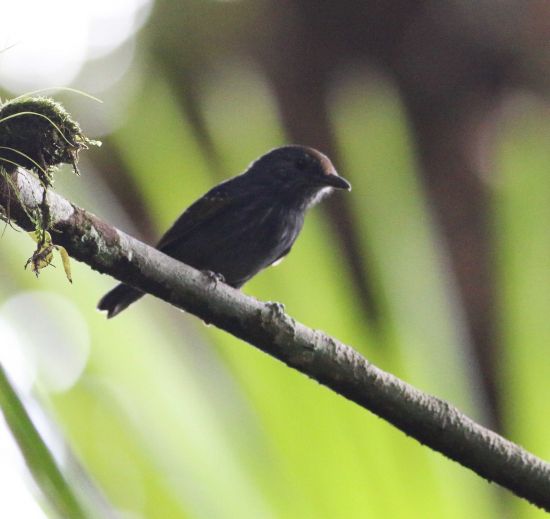
Female
Photo © by Daan van der hoeven
Merazonia Wildlife Refuge, Mera, Pastaza, Ecuador, 24 September 2019
Photo © by Daan van der hoeven
Merazonia Wildlife Refuge, Mera, Pastaza, Ecuador, 24 September 2019
- Dysithamnus occidentalis
Identification
13·5 cm (5¼ in)
- Blackish-grey plumage
- Lighter underparts
- White interscapular patch
- White-spotted black greater and median wing-coverts
Distribution
South America: found in Colombia and Ecuador
Taxonomy
Subspecies
There are 2 subspecies[1]:
- D. o. occidentalis:
- D. o. punctitectus:
- Eastern slope of Andes of Ecuador (western Napo and Morona-Santiago)
Habitat
Understorey of montane evergreen forests at heights between 900 to 2200 m.
Behaviour
Diet
Their diet consists of insects and arthropods, including caterpillars and moths.
Breeding
They construct an open cup-shaped nest from small rootlets. Both adults care for the young.
References
- Clements, J. F., T. S. Schulenberg, M. J. Iliff, S. M. Billerman, T. A. Fredericks, B. L. Sullivan, and C. L. Wood. 2019. The eBird/Clements Checklist of Birds of the World: v2019. Downloaded from http://www.birds.cornell.edu/clementschecklist/download/
- Avibase
- BirdLife International
- Zimmer, K. and M.L. Isler (2020). Bicolored Antvireo (Dysithamnus occidentalis), version 1.0. In Birds of the World (J. del Hoyo, A. Elliott, J. Sargatal, D. A. Christie, and E. de Juana, Editors). Cornell Lab of Ornithology, Ithaca, NY, USA. https://doi.org/10.2173/bow.bicant4.01
- NHEMA
Recommended Citation
- BirdForum Opus contributors. (2024) Bicolored Antvireo. In: BirdForum, the forum for wild birds and birding. Retrieved 9 November 2024 from https://www.birdforum.net/opus/Bicolored_Antvireo



